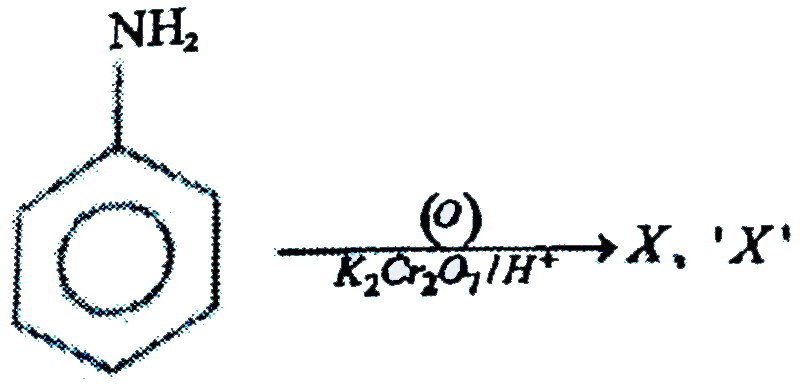Complete Solutions to SINGle Answer Questions(LEVEL-II) of chapter CHEMISTRY OF HEAVY METALS of Class 12 book with complete answers and questions
| Class 12 | CHEMISTRY |
| Chapter | CHEMISTRY OF HEAVY METALS |
| NARAYANA | SINGle Answer Questions(LEVEL-II) |
| Number Of Questions | 36 |
| Academic Year | 2023-24 |
`MnO_(4)^(-)` is intense pint colour, though Mn is `(+7)` oxidation state, It is due to
View SolutionWhen `SnCl_(2)` reacts with `HgCl_(2)`, the product formed are `:`
View SolutionWhen `MnO_(2)` is fused with `KOH,` a coloured compound is formed, the product and its colour is:
View SolutionWhich one of the following does not give a precipitate with excess of both NaOH solution and `NH_(3)` solution ?
View Solution`CuSO_(4)` solution reacts with excess of KCN solution to form:-
View SolutionThe compound used in the quanlitative and quantitative analysis of carbon and hydrogen in the organic compound is
View Solution`K_(2)CrO_(4)` is converted to `K_(2)Cr_(2)O_(7)` by
View SolutionThe compound formed during goldent yellow spangle test is
View SolutionWhich of the following is not formed when `FeC_(2)O_(4)` heated in the absence of air
View SolutionZinc carbonate is precipitated from zinc sulphate solution by the addition of:
View SolutionWhich of the following does not give a precipitate with alcoholic `AgNO_(3)` ?
View SolutionTo the `CuSO_(4)` solution, `NaHSO_(3)` and HCl were added followed by ammonium thiocanate solution. The compound formed is
View SolutionWhen `Pb_(3)O_(4)` is treated with conc. `HNO_(3)`, the insoluble product obtained is
View SolutionThe correct order of stability is
View SolutionThe precipitate obtained by adding lead nitrate solution to a sodium carbonate solution is
View SolutionWhich one of the following anions will give a white precipitate with `Pb(NO_(3))_(2)` solution ?
View SolutionPurple of Cassius is obtained by the addition of `SnCl_(2)` solution to a solution of
View Solution`Cr_(2)O_(7)^(2-)underset(Y)overset(X)hArr2CrO_(4)^(2-),` X and Y are respectively.
View SolutionAcidified chromic acid `+H_(2)O_(2)rarr underset(("blue colour"))(X+Y)`, X and Y are
View Solution`(NH_(4))_(2)Cr_(2)O_(7)` (ammonium dichromate) is used in fire works. The green coloured powder blown in air is:
View SolutionWhen `KMnO_(4)` solution is added to hot oxalic acid solution the decoloursitation is slow in the beginning but becomes instantaneous after some time. This is because
View SolutionComplete the following reaction

View SolutionWhich of the following metal liberates `H_(2)` from dil. `HNO_(3)`
View Solution`K_(2)MnO_(4)+Cl_(2)rarrX+KCl`
`Xoverset(200^(@)C)(rarr)A+B+O_(2)uarr` where 'B' is
View SolutionStatement `1:` Lithophone is preferred over white lead as white pigment.
Statement `2:` In the presence of `H_(2)S` present in air, white lead turns black.
View Solution`KMnO_(4)` is not used as primary standard because
View SolutionWhich of the following statement is wrong regarding copper sulphate.
View SolutionZnO shows yellow colour on heating due to
View SolutionWhen excess of `SnCl_(2)` is added to a solution of `HgCl_(2)`, a white precipitate turning to gray is obtained. The grey colour is due to
View SolutionWhich of the following is not formed when `FeC_(2)O_(4)` heated in the absence of air
View SolutionWhen `Cu^(2+)` solution reacts with excess `KI`. Which of the following statements is correct ?
View SolutionStatement 1`:` Concentrated solution of `CuCl_(2)` in water is yellow in colour.
Statement `2:` The concentrated solution contains `[CuCl_(4)]^(2-)` ion and `[Cu(H_(2)O_(4)]^(2+)` ion.
View SolutionStatement `1: FeCl_(2)` is a primary standard substance.
Statement `2:` The weight of `FeCl_(2)` does not change with time by any means.
View SolutionIn the oxidation reactions of `KMnO_(4)` , in acidic medium, only `H_(2)SO_(4)` is used to produce acidic medium but not HCl(or ) `HNO_(3)` because
View SolutionChoose the correct options ( true or false ) for the following statements.
`i)` FeO is stable enough at room temperature.
`ii) FeCl_(2)` on heating in air and in steam produces the same iron oxide.
`iii)` The colour of `FeCl_(2)` depends upon the number of water of crystallization.
View SolutionAgO actually exists as `Ag[AgO_(2)]`, which is diamagnetic in nature. Then which of the following statements is true regarding AgO?
View Solution
SINGle Answer Questions(LEVEL-II) questions and complete solutions for chapter CHEMISTRY OF HEAVY METALS of NARAYANA CHEMISTRY (HINGLISH) of Class 12
All Exercises from NARAYANA Class 12 CHEMISTRY CHEMISTRY OF HEAVY METALS
- Comprehension type Questions (passage)
- Integer Type Questions
- Integral
- Level III Single Answer Questions
- Level IV NCERT BASED QUESTIONS
- Level VI
- Level-V multiple answer questions
- Matric Matching questions
- Passage 1
- Passage 10
- Passage 11
- Passage 12
- Passage 13
- Passage 2
- passage 3
- Passage 4
- Passage 5
- Passage 6
- Passage 7
- Passage 8
- Passage 9
- Passage V
- Passage VI
- Passage VII
- Passage viii
- Passage-II
- Passage-III
- Passage-IV
- Previous IIT JEE Question
- Single Answer Questions
- SINGle Answer Questions(LEVEL-II)